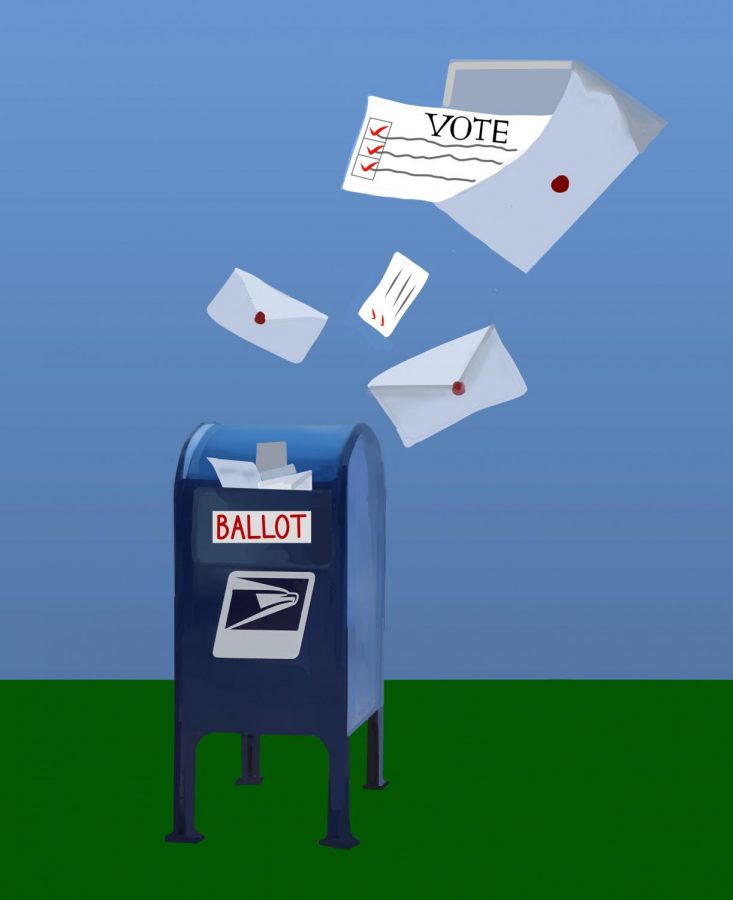The USPS controversy explained
What does voting look like in 2020?
Political scientists and researchers have refuted the president’s argument, saying that voting by mail neither increases election fraud nor gives either political party an advantage. Data from the Heritage Foundation, a conservative think tank, and analyzed by the Brookings Institution shows that there have only been 15 cases of voter fraud over a period of 19 years in Oregon, the first state to adopt a universal vote-by-mail foundation.
Recent changes in the leadership to the United States Postal Service (USPS) caused shockwaves across the country as postal workers and voters scrambled to manage widespread mail delays and concerns about voting in the upcoming election.
USPS Postmaster General and CEO Louis DeJoy was appointed by the Board of Governors in May despite concerns about a conflict of interest as he had previously served as a major donor to the Republican Party and a deputy finance chairman of the Republican National Committee.
On July 10, DeJoy implemented new measures for the USPS such as cutting overtime pay and banning late delivery trips, which led to delays in mail deliveries. Concerns also mounted after the organization made plans to remove 671 mail-sorting machines, infrastructure that will be essential to the collection of mail-in ballots for the November election.
Despite DeJoy issuing a statement in late August that the Postal Service will be able to handle any amount of election mail, USPS General Counsel and Executive Vice President Thomas J. Marshall sent letters to 46 states and Washington, D.C., warning that the organization cannot guarantee that ballots cast by mail will arrive in time to be counted since state rules are incongruous with postal timeframes.
John Lynch (12), who identifies as a conservative, agrees that the blame lies with the states, whose conflicting regulations make it impossible for ballots to be collected and counted in time. He also supports moving the election out to the end of December to allow sufficient time for votes to be cast, but believes that an extension beyond that would be a constitutional violation.
“It seems that most of the problem is actually on the states. They need to give the postal service more time to deliver the ballots. 92% of mail, the post office can get in time,” John said. “They deliver a ton of mail, so the added volume isn’t a huge deal to them. But, that means that 8% of ballots may not come in on time. So I think you need to get them more than just the seven days that they have right now, in order to give them that breathing room and ensure that ballots will eventually be delivered, even though it may take some time.”
Santa Clara County has offered several alternatives to ensure that ballots are counted. To submit a ballot, voters can go to a vote center, a drop box (there are over 98 in the county), go to the Registrar of Voters office for early voting, or place their ballot in the mail.
“There has been some information through social media that there’s been issues with the post office, so some people are worried about mailing in their ballots,” Debbie Bretschneider, city clerk for the city of Saratoga, said. “At Saratoga City Hall, starting at the beginning of October, there will be a very large ballot box locked down near the front of the parking lot, and anyone can come and drop off their ballots for free. The Registrar of Voters comes by twice a week to pick up those ballots.”
Evelyn Mendez, the public and legislative affairs manager for the Santa Clara County Registrar of Voters, said the city has implemented extensive changes to the vote centers in light of the coronavirus pandemic. Voting stations and tabulating machines have been adjusted for social distancing precautions, and the city has ensured sufficient masks and protective equipment for every voter should they choose to come to a vote center to seek any help with receiving or filling out their ballot.
Some states, like California, have universal vote-by-mail in which all voters are mailed ballots, but in most states, vote-by-mail takes the shape of absentee balloting where the voter must request an absentee ballot. In 2016, almost a quarter of votes were cast through either universal mailing systems or absentee ballots, according to the Election Assistance Commission.
DeJoy’s statements came in the midst of President Trump’s attacks on the process of voting by mail. Trump tweeted that the process of mail-in voting will lead to “the most inaccurate & fraudulent election in history,” and he encouraged North Carolinians to vote a second time after sending in their mail-in ballots “to see if it was counted,” in a tweet that has since been flagged by Twitter for violating its rules about civic and election integrity.
Political scientists and researchers have refuted the president’s argument, saying that voting by mail neither increases election fraud nor gives either political party an advantage. Data from the Heritage Foundation, a conservative think tank, and analyzed by the Brookings Institution shows that there have only been 15 cases of voter fraud over a period of 19 years in Oregon, the first state to adopt a universal vote-by-mail foundation.
On Aug. 16, House Speaker Nancy Pelosi (D-Calif.) announced that she would be calling the House of Representatives back into session to vote on House Oversight Chairwoman Carolyn Maloney’s (D-N.Y.) bill to prevent DeJoy’s changes from taking effect until the pandemic is over. The next day, seven senators, led by Senate Minority Leader Chuck Schumer (D-N.Y.) and Sen. Elizabeth Warren (D-Mass.) wrote to the USPS Board of Governors, asking them to reverse DeJoy’s operational changes and remove him from power if he refused to comply.
In a statement on Aug. 18, DeJoy issued a statement revoking his prior changes. Additionally, he pledged that starting Oct. 1, standby resources would be added to assist in USPS operations as needed. On Aug. 24, DeJoy was called to testify before the House Oversight Committee, where he defended his prior actions, reaffirming that he was not attempting to sabotage the election and pledging to do “everything in [his] power to deliver the ballots on time.”
Mendez encouraged high school students not yet eligible to vote to pre-register to vote. In the past, between 200 and 300 students have volunteered at vote centers to earn money and school credit, and the office is looking for more volunteers this year to sign up on the city website.
“We have a lot of openings, so there’s a big push out there to get high school kids to help us. My advice to first-time voters would be to know what your options are,” Mendez said. “Just make sure you have all the information; look at the state voter information guide to make sure you’re familiar with what you’re voting on and the candidates.”
Varsha Rammohan (12) is the co-editor-in-chief of Harker Aquila. This is her fourth year on staff, and she likes journalism since she can meet new people...
Arushi Saxena (12) is the co-managing editor of Harker Aquila. This is her fourth year on staff, and she hopes to develop her skills as a writer, photographer...

Nicole Tian (12) is the co-editor-in-chief of Harker Aquila. This is her fourth year on staff, and she previously served as the opinion editor, co-lifestyle...


















![“[Building nerf blasters] became this outlet of creativity for me that hasn't been matched by anything else. The process [of] making a build complete to your desire is such a painstakingly difficult process, but I've had to learn from [the skills needed from] soldering to proper painting. There's so many different options for everything, if you think about it, it exists. The best part is [that] if it doesn't exist, you can build it yourself," Ishaan Parate said.](https://harkeraquila.com/wp-content/uploads/2022/08/DSC_8149-900x604.jpg)




![“When I came into high school, I was ready to be a follower. But DECA was a game changer for me. It helped me overcome my fear of public speaking, and it's played such a major role in who I've become today. To be able to successfully lead a chapter of 150 students, an officer team and be one of the upperclassmen I once really admired is something I'm [really] proud of,” Anvitha Tummala ('21) said.](https://harkeraquila.com/wp-content/uploads/2021/07/Screen-Shot-2021-07-25-at-9.50.05-AM-900x594.png)







![“I think getting up in the morning and having a sense of purpose [is exciting]. I think without a certain amount of drive, life is kind of obsolete and mundane, and I think having that every single day is what makes each day unique and kind of makes life exciting,” Neymika Jain (12) said.](https://harkeraquila.com/wp-content/uploads/2017/06/Screen-Shot-2017-06-03-at-4.54.16-PM.png)








![“My slogan is ‘slow feet, don’t eat, and I’m hungry.’ You need to run fast to get where you are–you aren't going to get those championships if you aren't fast,” Angel Cervantes (12) said. “I want to do well in school on my tests and in track and win championships for my team. I live by that, [and] I can do that anywhere: in the classroom or on the field.”](https://harkeraquila.com/wp-content/uploads/2018/06/DSC5146-900x601.jpg)
![“[Volleyball has] taught me how to fall correctly, and another thing it taught is that you don’t have to be the best at something to be good at it. If you just hit the ball in a smart way, then it still scores points and you’re good at it. You could be a background player and still make a much bigger impact on the team than you would think,” Anya Gert (’20) said.](https://harkeraquila.com/wp-content/uploads/2020/06/AnnaGert_JinTuan_HoHPhotoEdited-600x900.jpeg)

![“I'm not nearly there yet, but [my confidence has] definitely been getting better since I was pretty shy and timid coming into Harker my freshman year. I know that there's a lot of people that are really confident in what they do, and I really admire them. Everyone's so driven and that has really pushed me to kind of try to find my own place in high school and be more confident,” Alyssa Huang (’20) said.](https://harkeraquila.com/wp-content/uploads/2020/06/AlyssaHuang_EmilyChen_HoHPhoto-900x749.jpeg)



